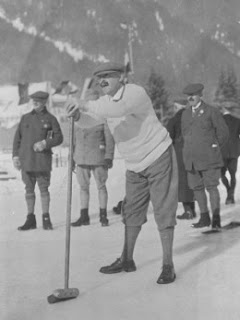Hockey History - The Danglebangle
Watching hockey today, it is sometimes hard to imagine the humble beginnings of the sport. Originally hockey evolved as a 'more refined pass-time for the more sophisticated gentleman' as early NHL legend Clogg Bradunkle described it in his 1912 memoirs "The Adventures of an Irish Mugwump Taking the Egg, Or, The Tale of Batty-fanged Tallywags". A more refined pass-time than what? Curling, which hockey was adapted from. At the turn of the twentieth century, curling was a widespread activity on the many frozen lakes and rivers of the Canadian prairies. The game had been brought over by Scottish immigrants and was quickly adopted. By the early 1900's rising nationalist sentiments coupled with a growing disdain for the broad appeal of curling led some of the newly rich men in Alberta to invent a new game to partake in during the 10 months of winter. A more refined pass-time, a game they would refer to as Hobbadehoy.
 |
| Hobbadehoy legend Clogg Bradunkle. Fort McMurray ca. 1907 |
The first games of hoddadehoy are thought to have been played in Fort McMurray on the Athabasca River. The game was considered by many at the time to be vulgar and did not initially catch on. It was mostly played by small local groups and there were no structure or even formal rules governing the game. The lack of formal rules turned out to be the perfect opportunity for one of hockey's first true innovators; Daniel Gallo.
Daniel Gallo was far from the typical hoddadehoy player, in fact, it is unknown how he was ever invited to play the game. He was the son of a French baker, who through a combination of bad decision making and a fiery temper had been forced to relocate from New York in 1896, when Daniel was 6 years old. The harsh climate and limited services available in Fort McMurray did not suit Daniel's father who quickly got into trouble. Soon after they arrived he was murdered when he was caught by a local farmer while defecating down the farmers chimney. Having no other family, Daniel grew up in abject poverty, not a typical background for the hoddadehoy players of the day.
The first mention of Daniel Gallo is from a report in the Fort McMurray Record, dated May 6th, 1918. The report is from a game of hoddedeboy and paints a vivid picture of the impact Gallo had: "But most astonishing of all was the elegant flight of the little cheese-eating surrender monkey from the docks. With grace not expected from a person of his stock he swooped among the fine gentlemen and recorded a crackling of Nommuses". We now know that Daniel Gallo, who was given the nickname Dan-Gal to avoid confusion with contemporary player Daniel Garmant, was the first to use skates in a game of hockey, an innovation that no doubt helps explain how commentators of the time were so stricken by his ease of movement. The advantage of being on skates enabled Gallo to dominate the sport. It also allowed for a less popular innovation Gallo brought to the game; as he collected his frequent winnings he would skate off at a pace that could not be matched and avoid the burden of buying the post game drinks.
 | |
| Daniel Gallo after his famous 18 goal game. An NHL record to this day. |
As the game once again adapted to his style, Gallo again found himself unable to compete and so devolved his own game to it's natural conclusion. Instead of going after the feet of nimble adversaries, he employed a tactic that can only be described as Lucician. Towards the end of his career, and coincidentally his life, his game had evolved into him skating around the center of the ice and whacking people in the head with his stick. He cared little if players were involved in the play or not, and won most of his games by knocking out all the other players before declaring that he was cold and taking off with the purse. This proved to be so effective that increasingly players opted to use a hard wood disc in place of their wallets, in an effort to get out of the game without any other damage than a severe concussion.
The constant maulings administered by Gallo not only changed the game, but also male fashion in Alberta. In an effort to protect themselves from the damaging effects of getting clubbed in the head, many of the young men in what is today the Wood Buffalo area would grow out their hair. A radical act in itself in 1920, made even more striking by their custom of styling their hair with wood glue. The long hair, and the hardened glue, worked together to form a primitive, and permanent, helmet. This style, most prominently cut with bangs for increased visibility, also took it's name from Daniel Gallo. It was referred to simply as the 'danglebangle', and while it is largely forgotten today, it was a feature in the NHL well into the 1980s before actual helmets became commonplace.
 |
| The Danglebangle |



Comments
Post a Comment